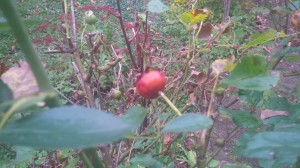
I grew up in western New York State, where winters were long, snowy and frigid. But even under those conditions, gardeners loved their roses and did their best to safeguard them against winter’s worst. My father, who was a romantic and a rose lover, went through an impressive annual winter rose preparation ritual that required careful pruning, bags and bags of cocoa bean mulch and enough burlap to swath the entire city of Buffalo.
Of course, his roses were mid- twentieth century hybrid teas, those divas of the garden that demanded tribute, adoration and most of all, personal services from gardeners. The roses were aided and abetted by “authorities” and merchandisers who regularly promoted rose care regimes that seemed designed to daunt all but the most slavish devotees. Some articles of the era made rose pruning sound so complicated that mastering the necessary skills would take a five-year apprenticeship at the Royal Botanic Gardens. Rose feeding schemes seemed more complicated than planning and executing a year of daily meals for a family of four.
Is it any wonder that so many of today’s gardeners are totally intimidated by the idea of growing roses?
If you want roses to survive whatever winter weather hits your area, the first thing to remember is to buy the right roses. If you can, choose “own root” varieties, rather than grafted types. In my father’s day, almost all commercially available roses were grafted, with top growth from a beautiful, but relatively weak-rooted variety grafted to the rootstock of a hardier one. Grafting makes for strong growers, but it also means that if the top growth is killed by cold or other conditions, the plant will either die all together or sprout new growth from the roots. This is how some people who plant white hybrid teas, like the classic ‘John F. Kennedy’, end up with red ‘Dr. Huey’ roses the year after a bad winter. ‘Dr. Huey’ is one of the most widely used rootstocks for grafted roses.
Own-root roses may also suffer total winter die-back, but if new growth sprouts the following spring, it will be true to variety.
How do you know if you have a grafted rose? Look at the lower third of the main stem; if you see a noticeable swelling, it is most likely the result of the grafting process. These days, many rose merchandisers print the information on plant tags or literature.
When you are buying new roses, make sure that they are reliably winter hardy in your USDA plant hardiness zone. Zone hardiness information is almost always available on plant tags. Websites can help as well. To find your area’s zone, go to http://planthardiness.ars.usda.gov/phzmweb/interactivemap.aspx and click on your state. Helpmefind.com/roses is an especially good source for rose-specific hardiness information and searchable by the varietal name.
Mulch is good for all roses at any time. Winter mulch, whether you use pine straw, shredded bark or buckwheat hulls, is an excellent insulator. The goal of winter mulch is to prevent heaves and other mayhem caused by the wide winter temperature fluctuations that many of us experience, so for best results, apply it after the ground has frozen. However, if you are like many gardeners who mulch once a year in the spring, don’t fret. Lightening will not strike you or your roses if you neglect winter mulching.
Pruning roses in late fall is another good idea. The aim is always to prevent damage caused by wind, ice and snow. This means a reduction in the overall length of the stems or canes, with special attention to long stems that are likely to whip around in high winds. Generally, cut back established roses by one third, with overgrown specimens or overeager stems receiving a two thirds chop. Much nonsense has been spouted about pruning to an outward- facing bud and much time has been wasted by those who worry too much about that. In practice, simply eyeball the one third or two thirds cutting line and apply your clippers or loppers. The rose will be fine. While you are at it, nip off any dead or damaged stems or canes. The only exceptions to the pruning rule are brand new roses, which probably don’t need any pruning, and situations where you want to preserve rose hips as winter food for the birds. If you like the hips, trim back only the extra-long canes.
If life would be irrevocably altered for you if you didn’t burlap your roses, go right ahead. It can’t really hurt them and might help extremely tender varieties. If you live in non-mountainous areas in the southern three quarters of the continental United States and grow either tough, grafted roses or own-root roses, burlapping is unnecessary. Not applying burlap also means that you don’t have to take it off and store it in the spring. My father had a corner of the garage dedicated to summer storage of the antique lengths of burlap that had snuggled his roses through decades of winters. It worked for him, but if the choice is to forgo burlap or forgo growing roses all together; choose the roses.
Winter rose care can be as simple or as complicated as you make it. Whatever you do, the roses are going to be outside on their own for the season. The majority will survive, and the bushes that don’t should probably be replaced with tougher varieties. I think stress-free rose admiration is much better fertilizer than slavish devotion.

